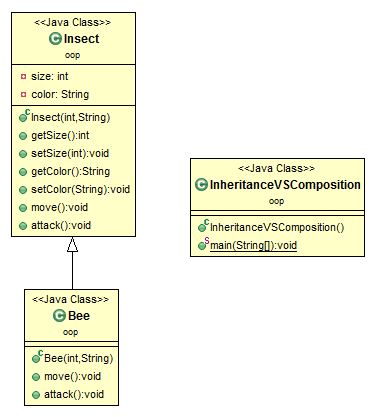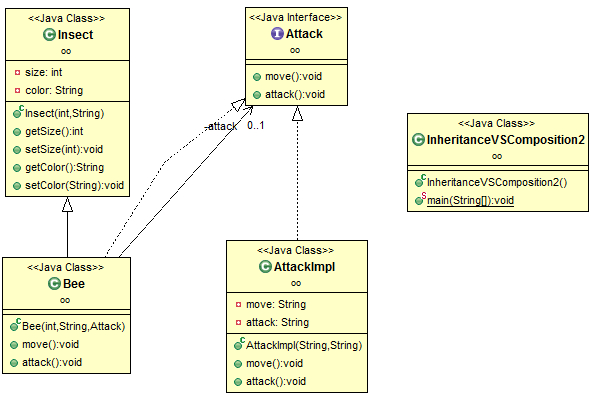Java____继承与组合
2015-09-02 09:22
543 查看
转载地址:http://www.programcreek.com/2014/05/inheritance-vs-composition-in-java/
This article illustrates the concepts of inheritance vs. composition in Java. It first shows an example of inheritance, and then shows how to improve the inheritance design by using composition. How to choose between them is summarized at the end.
1. Inheritance
Let's suppose we have an Insect class. This class contains two methods: 1) move() and
2)attack().
Now you want to define a Bee class, which is a type of Insect,
but have different implementations of attack() and move().
This can be done by using an inheritance design like the following:
The class hierarchy diagram is as simple as:

Output:
"Fly" was printed twice, which indicates move() is called twice. But it should be called only ONCE.
The problem is caused by the super.attack() method. The attack() method
of Insectinvokes move() method.
When the subclass calls super.attack(), it also invokes the overridden move() method.
To fix the problem, we can:
eliminate the subclass's attack() method. This will make the subclass depends on the superclass's implementation of attack().
If the attack() method in the superclass is changed later (which is out of your control), e.g., the superclass's attack() method use another method
to move, the subclass will need to be changed too. This is bad encapsulation.
rewrite the attack() method like the following:
This would guarantee the correct result, because the subclass is not dependent on the superclass any more. However, the code is the duplicate of the superclass. (Imageattack() method
does complex things other than just printing a string) This does not following software engineering rule of reusing.
This inheritance design is bad, because the subclass depends on the implementation details of its superclass. If the superclass changes, the subclass may break.
2. Composition
Instead of inheritance, composition can be used in this case. Let's first take a look at the composition solution.
The attack function is abstracted as an interface.
Different kinds of attack can be defined by implementing the Attack interface.
Since the attack function is extracted, Insect does not do anything related with attack any longer.
Bee is a type of Insect, it can attack.
Class Diagram:

3. When to Use Which?
The following two items can guide the selection between inheritance and composition:
If there is an IS-A relation, and a class wants to expose all the interface to another class, inheritance is likely to be preferred.
If there is a HAS-A relationship, composition is preferred.
In summary, Inheritance and composition both have their uses, and it pays to understand their relative merits.
This article illustrates the concepts of inheritance vs. composition in Java. It first shows an example of inheritance, and then shows how to improve the inheritance design by using composition. How to choose between them is summarized at the end.
1. Inheritance
Let's suppose we have an Insect class. This class contains two methods: 1) move() and
2)attack().
class Insect {
private int size;
private String color;
public Insect(int size, String color) {
this.size = size;
this.color = color;
}
public int getSize() {
return size;
}
public void setSize(int size) {
this.size = size;
}
public String getColor() {
return color;
}
public void setColor(String color) {
this.color = color;
}
public void move() {
System.out.println("Move");
}
public void attack() {
move(); //assuming an insect needs to move before attacking
System.out.println("Attack");
}
}Now you want to define a Bee class, which is a type of Insect,
but have different implementations of attack() and move().
This can be done by using an inheritance design like the following:
class Bee extends Insect {
public Bee(int size, String color) {
super(size, color);
}
public void move() {
System.out.println("Fly");
}
public void attack() {
move();
super.attack();
}
}public class InheritanceVSComposition {
public static void main(String[] args) {
Insect i = new Bee(1, "red");
i.attack();
}
}The class hierarchy diagram is as simple as:

Output:
Fly Fly Attack
"Fly" was printed twice, which indicates move() is called twice. But it should be called only ONCE.
The problem is caused by the super.attack() method. The attack() method
of Insectinvokes move() method.
When the subclass calls super.attack(), it also invokes the overridden move() method.
To fix the problem, we can:
eliminate the subclass's attack() method. This will make the subclass depends on the superclass's implementation of attack().
If the attack() method in the superclass is changed later (which is out of your control), e.g., the superclass's attack() method use another method
to move, the subclass will need to be changed too. This is bad encapsulation.
rewrite the attack() method like the following:
public void attack() {
move();
System.out.println("Attack");
}This would guarantee the correct result, because the subclass is not dependent on the superclass any more. However, the code is the duplicate of the superclass. (Imageattack() method
does complex things other than just printing a string) This does not following software engineering rule of reusing.
This inheritance design is bad, because the subclass depends on the implementation details of its superclass. If the superclass changes, the subclass may break.
2. Composition
Instead of inheritance, composition can be used in this case. Let's first take a look at the composition solution.
The attack function is abstracted as an interface.
interface Attack {
public void move();
public void attack();
}Different kinds of attack can be defined by implementing the Attack interface.
class AttackImpl implements Attack {
private String move;
private String attack;
public AttackImpl(String move, String attack) {
this.move = move;
this.attack = attack;
}
@Override
public void move() {
System.out.println(move);
}
@Override
public void attack() {
move();
System.out.println(attack);
}
}Since the attack function is extracted, Insect does not do anything related with attack any longer.
class Insect {
private int size;
private String color;
public Insect(int size, String color) {
this.size = size;
this.color = color;
}
public int getSize() {
return size;
}
public void setSize(int size) {
this.size = size;
}
public String getColor() {
return color;
}
public void setColor(String color) {
this.color = color;
}
}Bee is a type of Insect, it can attack.
// This wrapper class wrap an Attack object
class Bee extends Insect implements Attack {
private Attack attack;
public Bee(int size, String color, Attack attack) {
super(size, color);
this.attack = attack;
}
public void move() {
attack.move();
}
public void attack() {
attack.attack();
}
}Class Diagram:

public class InheritanceVSComposition2 {
public static void main(String[] args) {
Bee a = new Bee(1, "black", new AttackImpl("fly", "move"));
a.attack();
// if you need another implementation of move()
// there is no need to change Insect, we can quickly use new method to attack
Bee b = new Bee(1, "black", new AttackImpl("fly", "sting"));
b.attack();
}
}fly move fly sting
3. When to Use Which?
The following two items can guide the selection between inheritance and composition:
If there is an IS-A relation, and a class wants to expose all the interface to another class, inheritance is likely to be preferred.
If there is a HAS-A relationship, composition is preferred.
In summary, Inheritance and composition both have their uses, and it pays to understand their relative merits.
相关文章推荐
- java关闭流,解压缩后的清除
- Java删除文件夹和文件
- 打开Android studio遇到的一些问题,为什么安装jdk没有jdk.....的文件夹
- Java基础学习对象、封装第二章实验练习三
- java 基础学习对象、封装第二章练习二
- java 基础学习什么是对象第二章练习一
- Eclipse Configuration ButterKnife
- 2015.09.01 Java 学习笔记—内存分析精华
- Mybatis-spring基本配置
- Android开发效率—Eclipse快捷键
- Spring笔记――11.“零配置”支持
- java web session
- android布局,eclipse项目文件详情,监听器的设置
- java.io.NotSerializableException
- java文件预览及加密解密的部分问题及解决方案
- Spring笔记――10.两种后处理器
- 基于Java实现的简单且通用的分页实现封装 <Pagiation>
- Spring笔记――9.Srping3.0提供的SpEL 待续
- Spring笔记――8.基于XML Schema的简化配置
- Activiti整合到springMVC项目的详细配置
